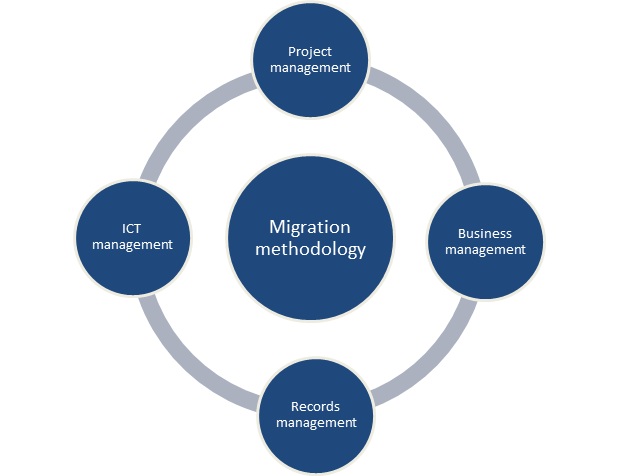Migrations require stakeholder engagement. To address this, the migration methodology identifies stakeholders groups that are involved in migrations as follows:
- Project management
- Business management
- Records management
- ICT management
The methodology allows that stakeholder groups will intersect throughout the course of the migration project as part of a collaborative process and each will have input into how the migration proceeds throughout the project lifecycle through to completion.
It is acknowledged that migrations will differ so there needs to be flexibility in how these stakeholder groups are engaged and utilised as part of migration projects.

Agencies involved in undertaking migration projects will be responsible for the business management. Specifically this will involve business owners of the records, business knowledge about the records and Executive sponsorship for migration projects. The following table outlines the roles of each of the stakeholder groups.
| Stakeholder Group | Outline | Roles and responsibilities | Responsible |
|---|---|---|---|
| Project management |
Project management provides the planning and reporting structure that allows effective management of:
Project documentation such as the project plan, risk and issue logs/reports, Gantt charts, status reports and stage reports are useful tools to manage projects. The project management method used should be tailored to suit migration projects in line with the framework of the migration methodology. |
The responsibility for leading the project and providing overall project management should be identified as part of the process of defining roles and responsibilities during project stakeholder identification. Project management is used throughout the migration project lifecycle. Responsibility for managing migration project costs needs to be identified in the project plan. Each project should include a cost/benefit analysis with the understanding that State Records NSW will be responsible for ongoing storage and management costs of digital records migrated to the Digital Archives. |
Project governance and project management are shared responsibilities between State Records NSW and agencies. |
| Business management |
Business management incorporates:
The business owner of the records should be able to:
|
The business is a key stakeholder in the migration project and, as the identified business owner of the records, plays an integral role as one of the key decision makers. The business owner of the records provides approval for the formal transfer of custody and control of digital records required as State archives from an agency to State Records NSW. Agency support for migration projects must come from the business owners and relevant authority in the agency. This support is essential for maintaining required agency activity on migration projects through to project completion. |
Agencies involved in undertaking migration projects will be responsible for the business management. Specifically this will involve business owners of the records, business knowledge about the records and Executive sponsorship for migration projects. |
| Records management |
Records management identifies requirements for the management of records in relation to statutory, regulatory and legislative requirements. The State Records Act 1998 is central to this although other key legislation includes the Privacy and Personal Information Protection Act 1998, the Government Information (Public Access) Act 2009 and any other legislation that may be relevant to the management, access and use of government information managed by agencies operating in specific functions and domains of activity. |
Records management determines the retention requirements for records. These requirements are defined in general and functional disposal authorities registered by State Records NSW. These disposal authorities incorporate appraisal, sentencing and disposal functions. |
The skill sets and resources for records management can come from both the agency and State Records NSW although there will be cases when the agency does not have adequate resources. |
| ICT management |
ICT management encompasses:
The technical skill sets involved in undertaking migrations can include in-house expertise within agencies and also specialist roles that can be provided either internally where available or by external stakeholders such as vendors and consultants. ICT represents an important stakeholder within migration projects because of the strong relationship with agency business divisions and units. |
ICT provides essential services to the business regarding the management of records including storage and access for users of agency records. ICT also has a strong relationship with records management to ensure the ongoing accessibility and usability of agency records. The ability to undertake migration projects effectively requires ICT stakeholders to have a close and collaborative role in project planning and migration planning as well as the migration itself. This role includes not only ICT skill sets but also resources to support the migration project. |
Agencies will need to supply ICT resources to assist in the migration project. These resources may be sourced internally or externally to the agency involved in the migration project. State Records NSW is responsible for migrating records into the Digital Archives, including identified digital preservation actions, and the ongoing management of the records once migrated. |
Published July 2014

